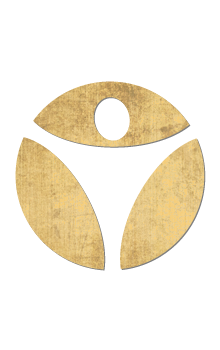Awesome Wide Legged Forward Fold with Shoulder Stretch – A How-To Guide For Inflexible Beginners
- Updated on: July 8, 2022

Importance of Wide Legged Forward Fold with Shoulder Stretch
- Stretches the inner thighs and hamstrings
- Improves mobility in the hips and ankles
- Helps relieves back pain
- Helps with lateral mobility for improved agility
- Stretches the shoulders, chest and upper arms
- Tones the abdominals
- Stimulates blood circulation for digestive organs
- Improves balance and stability
- Helps prevent soft tissue injuries in thighs and hips
- Strengthens knees by improving mobility of connecting muscles
Do’s
In order to do the Wide Legged Forward Fold With Shoulder Stretch correctly, here are the steps:
- Begin in a wide stance facing the long edge of your mat. Feet will be between 4 to 6 feet apart.
- Engage the arches of your feet by lifting them away from the ground and pressing the outer edges of your feet into the ground.
- Engage your thighs and squeeze them in toward one another.
- Interlace your hands behind your low back.
- Lengthen your spine, keeping you back flat, as you hinge forward at your hips.
- Squeeze your hip flexors and your core toward one another to activate support for the pose.
- Inhale to lengthen the spine, pulling the shoulders away from the hips.
- Exhale, let your hands raise away from your low back, lifting toward the sky. Get deeper into the pose by intensifying the activity in the hip flexors and core.
Don’ts
Common Mistakes Beginners Make
Not engaging the front of the thighs: Many beginners fail to engage the front of the thighs (quadriceps) in forward folding poses. This is a mistake because it decreases the frontal support for the back stretch. Engaging the front of the thighs helps to release tight hamstrings through the concept of antagonistic muscle pairs. This means that opposing pairs of muscles will always have one of the pair releasing while the other is engaging. In this case, the quadriceps engage to create a deeper release in the hamstrings.
Locking the knees: It is common to lock the knees in this pose. However, locking the knees puts unnecessary stress on the joints, and diminishes the strengthening benefits for the legs. Instead, work toward having straight legs with a slight softness in the knees. This will also help increase agility in the knees and legs.
Forgetting to engage the core: Make sure you are engaging your core while squeezing your quadriceps and hip flexors. It’s a common error to collapse into forward folding poses, focusing on stretching the back without paying attention to what’s happening to the front. Anytime the muscles of the back are being stretched, it is a good opportunity to strengthen the muscles of the front. Engaging the core provides much needed support for the forward fold, and can help prevent overstretching in the delicate muscles of the low back.
Rounding the back: Many beginners make the mistake of rounding the back during forward folding poses in an attempt to feel like they are bending more fully. However, this can overstretch the delicate muscles of the low back causing strain or injury. Keep the back flat with a long, straight spine, and let the fold happen at the hips for proper form.

Rolling to the edges of your feet: Be sure to avoid rolling to the outer or inner edges of your feet. In order to protect your ankle and knee joints, you need to plant your feet with the weight evenly distributed throughout the entire foot. That means giving equal weight to the front, back and center. Once planted, press into the outer edges of your feet.
Letting the hips shift behind the feet: Be careful to avoid letting your hips shift behind your feet in this pose. This can put unnecessary strain on the front of the ankles as well as limits the hamstring stretch you are able to get. This also sets your pose out of alignment, making it more challenging to maintain your balance. Bring your hips forward and use your core strength to prevent them from falling back.

Reason for Modification
You should consider a modification if you experience the following:
- Excessive tightness in the outer hips and thighs
- Limited mobility in the ankles
- Excessive tension in the knees
- Weakened or underdeveloped core
- Excessive back pain/discomfort or tension
- Discomfort or restriction in the shoulders
- Tight or restrictive wrists
- Difficulty maintaining balance
Modifications
Solutions to the Above
Excessive tightness in the adductor muscles (inner thigh/groin area) or hamstrings:
To decrease the demand on the adductor muscles of your inner thighs, shorten your stance so that your feet are closer together.
Alternatively, if you experience tightness in your hamstrings during Wide Legged Forward Fold with Shoulder Stretch, you can bend your knees or use blocks under your palms to release some of the tension.
You can also perform this pose sitting on a stool or on a chair to provide additional support. To do this, sit with your glutes on the edge of the seat and straighten your legs as you move them apart from each other. If using a backless stool, you will perform the rest of the pose as directed above. If using a chair with a back, you will bend forward first to clasp your hands behind your back. Then, proceed as instructed.
Limited mobility in the ankles:
This would make the pose harder for inflexible beginners. If you have limited mobility in your ankles, you can rotate your toes slightly in toward each other in a pigeon-toed stance.
Excessive tension or pulling at the back of the knees:
The easiest way for most people to modify this pose for tightness at the back of the knees is to bend the knees instead of keeping them straight. Bend them only as much as you need to to alleviate the discomfort.
Another option for those experiencing knee pain or limitation in this pose is to practice the pose by sitting on a stool or on a chair.
Weakened or underdeveloped core:
If your core is too weak or underdeveloped to support Wide Legged Forward Fold with Shoulder Stretch, you can leave the shoulder stretch out of it until you are stronger. Instead of clasping your hands behind your back, place your hands on the ground or on blocks beneath your shoulders while lengthening your spine and working on core engagement.

Excessive back pain, discomfort or tension:
If you’re feeling excessive tension or discomfort in your back during Wide Legged Forward Fold with Shoulder Stretch, first try the fold without the shoulder stretch. Instead of clasping your hands behind your back, you can place your hands on the ground or on blocks beneath your shoulders while lengthening your spine and working on core engagement.

Another modification is to rest your chest on the back of a chair. It is important not to let your chest collapse completely into the back of the chair, but rather use it as an additional support as you continue to activate and strengthen your core and the front of your thighs. You can also use the seat of the chair in the same way that you would use blocks on the floor, by bringing the ground up to a more moderate height.

Discomfort or restriction in the shoulders:
If your shoulders are very tight and restrictive, you can eliminate the shoulder stretch from Wide Legged Forward Fold with Shoulder Stretch and focus on the back-bending qualities. Instead of clasping your hands behind your back, place your hands on the ground or on blocks beneath your shoulders while lengthening your spine and working on core engagement.

An easier modification would be to begin with the modification above, so that your hands are under your shoulders either on the ground or on blocks. Shift your weight slightly into one arm raising the other up toward the sky with the palm facing the ground. Then repeat on the other side. This provides a gentler shoulder stretch.
If you have trouble clasping your hands behind your back, you can hold a strap. Begin by holding one end of the strap in one hand. With the remaining hand, grab the strap at whatever point provides a comfortable stretch for you across the front of the shoulders. Both palms will be facing in toward each other. Continue with the rest of the pose as instructed above.

Tight or restrictive wrists:
If your wrists don’t allow you to clasp your hands behind your back, you can hold a strap instead. Begin by holding one end of the strap in one hand. With the remaining hand, grab the strap at whatever point provides a comfortable stretch for you across the front of the shoulders. Both palms will be facing in toward each other. Continue with the rest of the pose as instructed above.
Difficulty maintaining balance:
The easiest way to modify this pose when you have trouble maintaining balance is to eliminate the shoulder stretch and focus on the back-bending qualities. Instead of clasping your hands behind your back, place your hands on the ground or on blocks beneath your shoulders while lengthening your spine and work on core engagement.
You can practice the Wide Legged Forward Fold With Shoulder Stretch against a wall if you find it difficult to maintain balance. Begin standing with your back about an inch away from the wall. When doing this modification, don’t clasp your hands behind your back until you begin to hinge forward in order to ensure there’s enough space behind you. As you begin to lift your arms toward the sky, you can sit your butt against the wall to maintain balance.
You can also perform this pose sitting on a stool or in a chair. This can provide additional support if balance is an issue.
Another modification is to rest your chest on the back of a chair. It is important not to let your chest collapse completely into the back of the chair, but rather use it as an additional support as you continue to activate and strengthen your core and the front of your thighs.
Common Questions
- When is Wide Legged Forward Fold With Shoulder Stretch contraindicated?
- How far forward should I lean in Wide Legged Forward Fold With Shoulder Stretch?
- What do I do if I feel pinching in my back?
- how wide to go? How wide should my legs be in this pose?
- what is the difference between this and a forward fold What is the difference between this and a forward fold?
- what does it mean if you hear or feel popping in this pose? What does it mean if you hear or feel popping in this pose?
When is Wide Legged Forward Fold With Shoulder Stretch contraindicated?
If you have any of the following conditions during Wide Legged Forward Fold with Shoulder Stretch, explore a modified version of the pose to avoid discomfort or further injury:
Acute back injury
Acute hip, knee or ankle injury
Acute shoulder injury
Blood pressure imbalances
Active migraines
Vertigo or other conditions affecting balance
How far forward should I lean in Wide Legged Forward Fold With Shoulder Stretch?
It is only necessary to lean as far forward as you need to feel a stretch in your back while still maintaining full engagement in your core and thighs. If you begin to feel pinching or other discomfort in your low back, hips, or legs, decrease the degree of the fold.
What do I do if I feel pinching in my back?
The first thing to do is to decrease the degree of the fold. You can also try the modifications listed above for a safer and more comfortable way to experience Wide Legged Forward Fold with Shoulder Stretch.
How wide should my legs be in this pose?
There is no specific distance between the feet that is required for Wide Legged Forward Fold with Shoulder Stretch pose. A good starting point is around 3-4 feet apart. However, if you experience excessive rounding of your back you can use blocks or widen your stance, and if you feel strain on your hamstrings or muscles of the inner thigh, try shortening your stance. Pro tip for all poses is to listen to and feel the feedback from your body and adjust the pose for your body’s comfort.
What is the difference between this and a forward fold?
Wide Legged Forward Fold With Shoulder Stretch is a forward fold. It is simply a variation with the feet farther apart that directs the primary stretch in the legs toward the upper, inner thighs more specifically, while still targeting the hamstrings on the backside of your legs. Adding the shoulder stretch provides additional stretching through the front of the chest and shoulders as well.
What does it mean if you hear or feel popping during Wide Legged Forward Fold with Shoulder Stretch pose?
Popping sounds while stretching or moving joints can be caused by several things, which include tightness of muscles causing friction on the bone; cartilage that has worn down over time creating rough surfaces that rub together; and pressure being released from joints as the fluid which lubricates the joints becomes gaseous and makes the cracking or popping sounds.
These sounds can be a normal occurrence if there is no pain; however if this occurs in excess or if you feel any discomfort (pain, numbness, pins and needles feeling) following the popping, come out Wide Legged Forward Fold with Shoulder Stretch pose immediately and consult your healthcare provider before continuing your practice.
Recent Posts
Categories
Related Articles
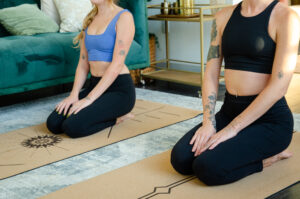
Breathing technique to improve your yoga practice
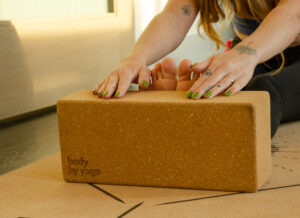
Benefits of yoga before bed
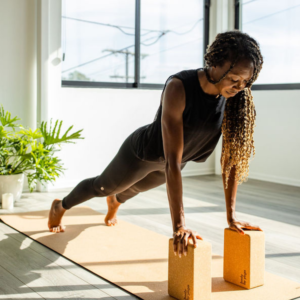
Taking the next step to more challenging yoga
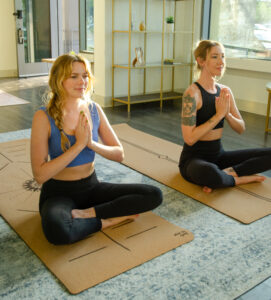
Hatha vs Power yoga
Related Articles
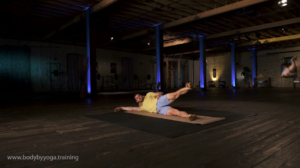
Stretching and Strengthening your hips
In this workout we start slow to warm up your hips. Utilizing low impact workouts like this can be important for beginners and yoga veterans

Hatha vs Power yoga
We’ve created our own unique style of slow burn power yoga that combines Hatha yoga, power yoga, bodyweight exercises and physical therapy. This way in

The importance of maintaining correct alignment
Everything in your body is connected, so when one muscle isnt aligned properly it can be a slippery slope to injury. Building a solid foundation
